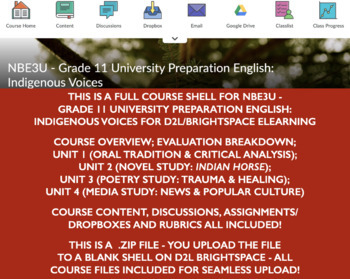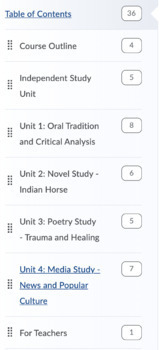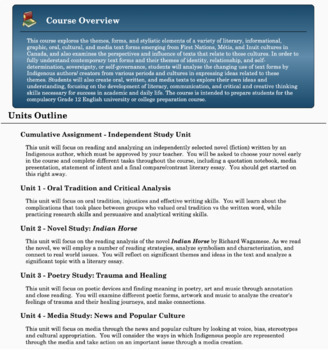NBE3U D2L Brightspace Full Course - Grade 11 English, Indigenous Voices
- Zip
What educators are saying
Description
This is a full course shell for the course NBE3U - Grade 11 University Preparation English: Indigenous Voices (Ontario Curriculum) - to be uploaded on D2L/Brightspace. It can be easily used in a face-to-face classroom or an eLearning course, as it is ready to be shared with students immediately.
NBE3U is meant to replace ENG3U to incorporate Indigenous voices and perspectives into the curriculum. It still follows the requirements and expectations of a 3U English course.
This .zip file must be uploaded to a D2L shell and all files, images, texts, links, etc will be up and running. If you personally do not use D2L, but work in an Ontario school board, you still have access to D2L as it is managed by the Ministry of Education.
Throughout the course, perspectives from various First Nations, Métis and Inuit peoples are included, as well as other BIPOC.
Course Table of Contents:
- Course Overview
- Evaluation Breakdown/Recommendations
- Independent Study Unit (ISU)
- Unit 1 - Oral Tradition and Critical Analysis
- Unit 2 - Novel Study: Indian Horse
- Unit 3 - Poetry Study: Trauma and Healing
- Unit 4 - Media Study: News and Popular Culture
D2L Files include:
- Course Content
- Discussion Prompts and Discussion Boards
- Assignments and Dropboxes
- Rubrics
Learning Goals are included for each Unit and individual Lesson.
There are 26 Lessons (most would be over several days), 18 Discussion Posts and 20 Dropbox Assignments.
Rubrics are included for all forms of Assessment.
Independent Study Unit (ISU) includes:
- Independent Reading Assignment (overview and list of authors* to choose from)
- Quotation Notebook (outline and exemplar included)
- Media Presentation (outline)
- Compare/Contrast Literary Essay (with full essay worksheets** in D2L and Google Docs)
Unit 1 - Oral Tradition and Critical Analysis includes lessons on:
- Unit Overview
- Introduction to Oral Tradition (oral tradition, terminology)
- Messages and Agreements (wampum belts and creation stories)
- Effective Writing (generating ideas, writing essays)
- Passing on the Knowledge (ways in which Indigenous communities pass on knowledge)
- Oral Tradition vs the Written Word (medicine wheel, 7 grandfather teachings, treaties)
- Secondary Sources (primary and secondary sources)
- Using Our Voices (research and media representation and analysis)
Unit 2 - Novel Study: Indian Horse includes lessons on:
- Unit Overview
- Pre-Reading Research (historical and contemporary context of novel regarding residential schools, colonization, worldviews, etc)
- Chapters 1-20 (chapter questions***, real world connections, themes)
- Chapters 21-36 (chapter questions***, real world connections, themes)
- Chapters 37-56 (chapter questions***, real world connections, themes)
- Literary Essay (with full essay worksheets** in D2L and Google Docs)
Unit 3 - Poetry Study: Trauma and Healing includes lessons on:
- Unit Overview
- Introduction to Poetry (why we study poetry, terminology, annotation)
- Trauma Through Poetry and Art (poems and art on missing/murdered Indigenous women, stuck living between two worlds, destruction of the environment; how to analyze artwork)
- Healing Through Poetry and Music (poems and music on healing, voices of Indigenous youth, connected to "I Lost My Talk"; how to examine music)
- Poems, Music and Art (poetry analysis and creative piece summative)
Unit 4 - Media Study: News and Popular Culture includes lessons on:
- Unit Overview
- Introduction to Media (why do we study media, terminology, media literacy)
- Media Bias and the News (what is bias, analyzing bias, perspectives on pipelines)
- Stereotypes and Cultural Appropriation (videos and texts from variety of BIPOC)
- Indigenous Representation in the Media (representations of Indigenous people and particularly Indigenous women; Sports Logos; Hollywood representation)
- "On The Trail of the Hollywood Indian" (link to access the film Reel Injun, film questions)
- Taking Action Through Media Creation (action, awareness and activism; PSA videos) (*note: hoping to update this in the near future to be a social media activism campaign instead)
* The list of authors for the ISU includes Joseph Boyden. The First Nation closest to my school has hosted Boyden at events for Indigenous authors since the controversy. You may choose to remove him from the list.
** The Essay worksheets for Unit 2 and the ISU are linked to Google Docs and are 25 pages in length each for students to follow the writing process. They also include links to screencast videos that guide students through specific sections on how they can analyze quotations and more.
*** The chapter questions for Indian Horse do not include an answer key; they are listed as optional for students to complete. For a face-to-face class, I normally have students discuss these questions in groups so they can help each other understand the novel as they read.
If you have any questions about the course, please do not hesitate to contact me at sheenasteachingstuff@gmail.com !
SELLER NOTE: In my 12 years of teaching, my main subject focus has been Indigenous Studies and integrating Indigenous history, culture and perspectives into all subjects of the curriculum. While I am not an Indigenous person, I have endeavoured as a settler ally to make connections to nearby Indigenous communities and Knowledge Keepers, and have taken numerous courses to learn as much as I can to pass on to students. I have also worked with and supported First Nations, Métis and Inuit youth through alternative education programs connected with Friendship Centres and as a Student Success Teacher/Grad Coach. I am also currently pursuing my Master of Education with a focus on Indigenous Education. While I think this is a great resource, I would also encourage you to connect with your Indigenous Education department in your school board to ensure teaching and learning experiences are authentic. Thank you, miigwech.




